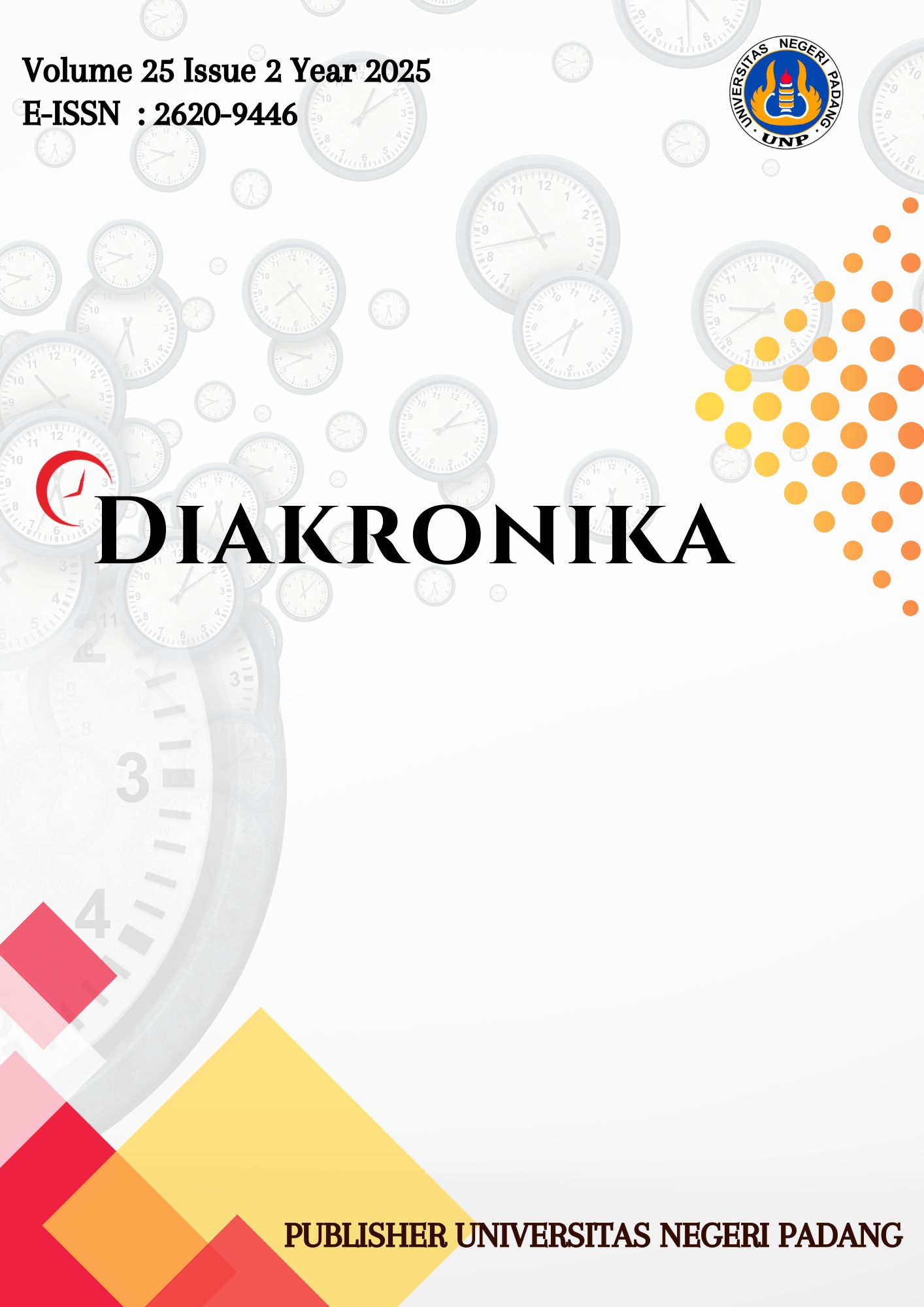Lingga Yoni site in Tasikmalaya: Overlooked Educational Potential Amidst the Threat of Exploitation of Nature
Abstract
The Lingga Yoni Indihiang site in Tasikmalaya is a cultural remnant of the Hindu-Buddhist period that has high historical, spiritual, and archaeological value. Based on the results of excavations and carbon tests, the site is estimated to date back to the 7th century AD. This research is motivated by a number of problems, including the threat of environmental exploitation due to sand and asphalt mining activities adjacent to the site, the problem of access to land controlled by the private sector, and the low use of the site as a medium for learning history. These problems are exacerbated by the lack of publications, the lack of supporting facilities, ownership conflicts, and differences in religious views of the surrounding community. This study uses a descriptive qualitative method with a case study approach. Data collection techniques are carried out through field observations, interviews with stakeholders (site managers, surrounding communities, and related agencies), and documentation studies of relevant literature and archives. The research location focuses on the Lingga Yoni site area in the Indihiang District, Tasikmalaya City. The results of the discussion show that although there have been physical preservation measures, such as the installation of fences, these efforts have not addressed the structural challenges faced by the site. A participatory-based preservation strategy is needed that involves the active role of the community, educational institutions, and the government collaboratively. The conclusion of this study emphasises the importance of integrated site management so that Lingga Yoni Indihiang can function optimally as a protected cultural heritage as well as a means of education and local identity of Tasikmalaya. encouraging students to think critically and gain a deeper understanding of history.
Downloads
References
Andaka, J. B. (2023). Kajian terhadap Lingga-Yoni Berbentuk Unik di Jawa (Yoni Bundar Temanggung, Yoni Liyangan, Yoni Gambar, dan Lingga-Yoni Candi Sukuh) sebagai Sumber Pembelajaran Sejarah. Winaya: Jurnal Pendidikan, 1(1), 16–23.
Cosgrove, D. (1985). Prospect, perspective and the evolution of the landscape idea. Transactions of the Institute of British Geographers, 10(1), 45–62.
Creswell, J. W. (2018). Research Design Qualitative, Quantitative, and Mixed Methods Approaches. SAGE Publications.
Dokumen. (2012). Balai Arkeologi Bandung.
Dokumentasi Ekskavasi 2012 - 2013. (2013). Balai Arkeologi Bandung.
Gracia. (2024). Wawancara terkait Pembelajaran di Sekolah.
Hartati, U. (2020). Cagar Budaya Sebagai Sumber Belajar Sejarah Lokal. Diakronika, 20(2), 143. https://doi.org/10.24036/diakronika/vol20-iss2/155
Hidayat, C. S. (2024). Wawancara terkait Pembelajaran di Sekolah.
Hidayati, A. U. (2017). Melatih Keterampilan Berpikir Tingkat Tinggi dalam Pembelajaran Matematika pada Siswa Sekolah Dasar. Jurnal Pendidikan Dan Pembelajaran Dasar, 4(2), 143–156.
Irfan. (2024). Wawancara terkait Pembelajaran di Sekolah.
Jokilehto, J. (2017). A History of Architectural Conservation. Routledge.
Karima, E. M., Wulandari, F. T., Firza, F., & Abianza, E. (2024). Transversal competencies in augmented reality-based history learning. Jurnal EDUCATIO: Jurnal Pendidikan Indonesia, 10(2), 299-308.
Maulana, R. A. (2024). Wawancara terkait Pembelajaran di Sekolah.
Miles, M.B, Huberman, A. ., & Saldana, J. (2014). Qualitative Data Analysis, A Methods Sourcebook, Edition 3. SAGE Publications.
Miller, D. (1987). Material Culture and Mass Consumption. Blackwell.
Moleong. (2019). Metodologi Penelitian Kualitatif. PT Remaja Rosdakarya.
Mubarok, A. (2024). Wawancara terkait Pembelajaran di Sekolah.
Poria, Y., Reichel, A., & Cohen, R. (2013). Tourists perceptions of World Heritage Site and its designation. Tourism Management, Elsevier, 35, 272–274.
Rizki Saparudin, M., Wasta, A., & Ridwan Husen, W. (2022). Analisis Prosesi Upacara Adat Nyapu Kabuyutan di Situs Lingga Yoni Indihiang Kota Tasikmalaya. Jurnal Pendidikan Seni, 5(2), 251–261.
Rusliana, & Henliyeni. (2024). Wawancara terkait Situs Lingga Yoni Kota Tasikmalaya.
Sugiyono. (2017). Metode Penelitian Kuantitatif, Kualitatif, dan R&D. Alfabeta.
Suprapta, B. (2016). Model Pemanfaatan Cagar Budaya untuk Kesejahteraan Masyarakat Studi Kasus Event Malang Kembali. Sejarah Dan Budaya Jurnal Sejarah Budaya Dan Pengajarannya, 10(1), 11–28.
Suta, I. M. (2018). Fungsi Dan Makna Lingga Dalam Ajaran Agama Hindu. Jurnal Ilmiah Ilmu Agama Dan Ilmu Sosial Budaya, 13(2), 88–100.
Thalita. (2024). Wawancara terkait Pembelajaran di Sekolah.
Undang-Undang Republik Indonesia. (2010). Undang-Undang Republik Indonesia Nomor 11 Tahun 2010 Tentang Cagar Budaya.
Wibowo, B. A. (2016). Pemaknaan Lingga-Yoni Dalam Masyarakat Jawa-Hindu Di Kabupaten Banyuwangi Provinsi Jawa Timur: Studi Etnoarkeologi. Humanis, 14(1), 9–16.
Widyastuti, E. (2013). Bangunan Suci dan Lingkungannya di Situs Indihiang Kota Tasikmalaya. In Balai Arkeologi Bandung.
Widyastuti, E. (2017). Arsitektur bangunan suci di situs Indihiang Kota Tasikmalaya. Purbawidya, 6(1), 19–31.
Wiley, J. E. T., & Ashworth., G. J. (1996). Dissonant heritage: The management of the past as a resource in conflict. In Chichester.
Zarah. (2024). Wawancara terkait Pembelajaran di Sekolah.





